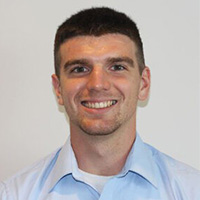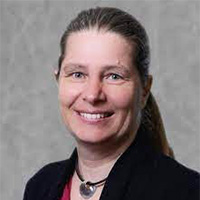By Justen Geddes and Mette S. Olufsen
Postural orthostatic tachycardia syndrome (POTS) currently affects as many as three million people in the U.S. [8], the majority of whom (approximately 80 percent) are young women [1]. The disorder is characterized by a heart rate (HR) increase of at least 30 beats per minute (more than 40 if the patient is younger than 19 years old) upon an orthostatic posture change, such as the transition from sitting to standing. In addition to this abnormal HR increase, POTS symptoms include lightheadedness, shortness of breath, heart palpitations, chest pain, gastrointestinal symptoms, and headaches [9]; in severe cases, patients are unable to partake in normal life activities. While the exact cause of POTS is unknown, the syndrome likely has several phenotypes: neuropathic POTS, which results from dysregulation in lower vasculature control; hyperadrenergic POTS, which results from increased plasma norepinephrine levels; and hypovolemic POTS, which is found in patients with low central blood volume [6].
The current diagnostic criteria for POTS include a sustained HR increase in response to orthostatic change with no corresponding drop in blood pressure (BP), combined with a history of chronic orthostatic intolerance [1]. Because all POTS patients display these standards, they cannot differentiate potential phenotypes. To better understand how each phenotype influences HR and BP in response to postural change that is imposed by a head-up tilt (HUT), we analyzed HR and BP time-series data and built a mechanistic model that encodes the three different phenotypes.
Figure 1. Signal processing pipeline. 1a. Heart rate (HR) and blood pressure (BP) time-series data from a POTS (top) and control (bottom) subject at rest (\(𝑡 < 200\) s) and after head-up tilt (HUT) (\(𝑡 > 200\) s). 1b. HR and systolic BP low-frequency intrinsic mode functions (IMFs). 1c. The power of the IMF 0.1 Hz signal during HUT for the control (left) and POTS (right) subject. Figure courtesy of the authors.
Along with abnormal HR increase, a visual inspection of continuous HR and BP time-series data (see Figure 1a) revealed that low-frequency (approximately 0.1 Hz) oscillations are more prominent in POTS patients when compared to control subjects (see Figure 1c). This finding agreed with previous studies [7]. Researchers believe that these low-frequency oscillations—sometimes referred to as Mayer waves—stem from resonance in the baroreflex feedback system [5]. Here we test the hypothesis that (i) neuropathic POTS patients experience only an increase in HR, (ii) patients with hyperadrenergic POTS experience both an increase in HR and low-frequency oscillations, and (iii) symptoms are more severe in patients with low blood volume.
To test our hypothesis, we use a nonstationary signal processing technique called uniform phase empirical mode decomposition (UPEMD) [3, 10] to quantify oscillations and apply mechanistic modeling [4] to explain their origins. Figure 1 displays our analysis pipeline. UPEMD iteratively “sifts” out stationary frequency components—called intrinsic mode functions (IMFs)—that represent relevant frequencies (see Figure 1b). We then quantify the IMFs via Fourier transform to compute frequency, amplitude, and phase. Analysis of the results that compare POTS patients to control subjects confirms our hypothesis that POTS patients exhibit increased low-frequency (≈0.1 Hz) HR and BP oscillations during HUT.
Figure 2. Model schematic and exploration of parameter space. 2a. Cardiovascular and baroreflex model. 2b. Increasing (left) and decreasing (right) Hill functions, which are used in baroreflex control equations. These functions ensure saturations as well as high and low values of the controlled variable. 2c. Amplitude of 0.1 Hz oscillations that is computed via Fourier transform. Values of kR and kH in blue (upper left) represent control subjects with no heart rate or blood pressure oscillations, while values in yellow (lower right) indicate high oscillations. POTS patients in Figure 3 utilize values in the center region. Figure courtesy of the authors.
To explain the cause of these oscillations, we developed an ordinary differential equations model that predicts baroreflex response to HUT (see Figure 2a). This model has both a cardiovascular and a baroreflex submodel. The cardiovascular submodel—analogous to an electrical circuit—comprises five differential equations that relate pressure (akin to voltage), flow (akin to current), and volume (akin to charge) in the heart, upper and lower arteries, and veins. We simulate HUT by tilting the modeled patient head-up to an angle of 60 degrees, after which gravity shifts blood volume from the upper part of the body to the lower part. To compensate for the change in pressure, the baroreflex submodel—which we formulate with first-order kinetic differential equations—regulates heart rate, end diastolic elastance, and upper- and lower-body peripheral vascular resistance as a function of blood pressure. We implement the response for each control by employing Hill functions that saturate at both low and high values of pressure (see Figure 2b).
Simulations with this model demonstrate that low-frequency HR and BP oscillations emerge, their amplitudes grow as a function of the Hill function steepness (see Figure 2c), and the increase in HR occurs when one decreases the half-saturation value. We simulate neuropathic POTS patients who experience decreased lower-body vascular control by decreasing the saturation limits in the baroreflex equations that predict lower-body peripheral vascular resistance. These patients do experience an increase in HR, but low-frequency oscillations are not as pronounced as in people with hyperadrenergic POTS (see Figures 3b and 3c). Finally, our simulations reveal that a lower blood volume alone does not cause POTS. When combined with hyperadrenergic POTS, however, a decrease in blood volume leads to an increase in oscillation amplitude (see Figure 3c). This observation agrees with clinical insights that patients with lower blood volume experience worse POTS symptoms.
Figure 3. Model simulations for a (3a) control subject, (3b) neuropathic POTS patient, and (3c) hyperadrenergic POTS patient with a central blood volume of 4,500 ml (blue) and 3,500 ml (red). Figure courtesy of the authors.
While our simple model explains the emergence of POTS and hypothesizes the ways in which POTS may differ in patients with varying phenotypes, it does not explain what stimulates the response. Recent studies [2] have noted that POTS patients express agonistic autoantibodies that bind to autonomic receptors in the heart and vasculature, which likely increase the sensitivity of specific receptors in the smooth muscle and sinoatrial nerve cells. We plan to study this phenomenon by deriving a multiscale model to predict the cellular dynamics of the sinoatrial node and smooth muscle cells. Preliminary results confirm that low-frequency oscillations increase with the increasing sensitivity of specific receptors.
In conclusion, we utilized nonstationary signal processing and found that POTS patients experience higher-amplitude low-frequency oscillations when compared to control subjects. We also used modeling to demonstrate that POTS patients have more sensitive baroreflex control systems. Finally, we discovered that patients with low blood volume experience more pronounced symptoms. Future studies will employ a multiscale cell model to explore these observations in further detail and differentiate data analysis to separate patients with neuropathic and hyperadrenergic POTS.
Justen Geddes presented this research during a contributed presentation at the 2021 SIAM Annual Meeting, which took place virtually in July.
References
[1] Fedorowski, A. (2019). Postural orthostatic tachycardia syndrome: Clinical presentation, aetiology and management. J. Int. Med., 285(4), 352-366.
[2] Fedorowski, A., Li, H., Yu, X., Koelsch, K.A., Harris, V.M., Liles, C., …, Kem, D.C. (2017). Antiadrenergic autoimmunity in postural tachycardia syndrome. Europace, 19(7), 1211-1219.
[3] Geddes, J., Mehlsen, J., & Olufsen, M.S. (2020). Characterization of blood pressure and heart rate oscillations of POTS patients via uniform phase empirical mode decomposition. IEEE Trans. Biomed. Eng., 67(11), 3016-3025.
[4] Geddes, J., Ottesen, J.T., Mehlsen, J., & Olufsen, M.S. (2021). Postural orthostatic tachycardia syndrome explained using a baroreflex response model. Preprint, arXiv:2109.14558.
[5] Julien, C. (2006). The enigma of Mayer waves: Facts and models. Cardiovasc. Res., 70(1), 12-21.
[6] Mar, P.L., & Raj, S.R. (2020). Postural orthostatic tachycardia syndrome: Mechanisms and new therapies. Ann. Rev. Med., 71, 235-248.
[7] Medow, M.S., Del Pozzi, A.T., Messer, Z.R., Terilli, C., & Stewart, J.M. (2014). Altered oscillatory cerebral blood flow velocity and autoregulation in postural tachycardia syndrome. Front. Physiol., 5, 234.
[8] Raj, S.R., & Robertson, D. (2018). Moving from the present to the future of postural tachycardia syndrome – what we need. Auton. Neurosci., 215, 126-128.
[9] Shaw, B.H., Stiles, L.E., Bourne, K., Green, E.A., Shibao, C.A., Okamoto, L.E., …, Raj, S.R. (2019). The face of postural tachycardia syndrome – insights from a large cross-sectional online community-based survey. J. Int. Med., 286(4), 438-448.
[10] Wang, Y.-H., Hu, K., & Lo, M.-T. (2018). Uniform phase empirical mode decomposition: An optimal hybridization of masking signal and ensemble approaches. IEEE Access, 6, 34819-34833.
 |
Justen Geddes is a Ph.D. candidate in biomathematics at North Carolina State University, where he is advised by Mette S. Olufsen. His research focuses on the data analysis and mathematical modeling of physiological systems using multiscale modeling approaches. |
 |
Mette S. Olufsen is a professor of mathematics at North Carolina State University. Her current interests include patient-specific modeling of cardiovascular and inflammatory dynamics, sensitivity analysis, parameter inference, and methods for the construction of spatial networks from imaging data. She is director of the Directed Research for Undergraduates in Mathematics and Statistics (DRUMS) Research Experiences for Undergraduates (REU) program, an adjunct professor in biomedical engineering, and a contributor to the biomathematics graduate program. |